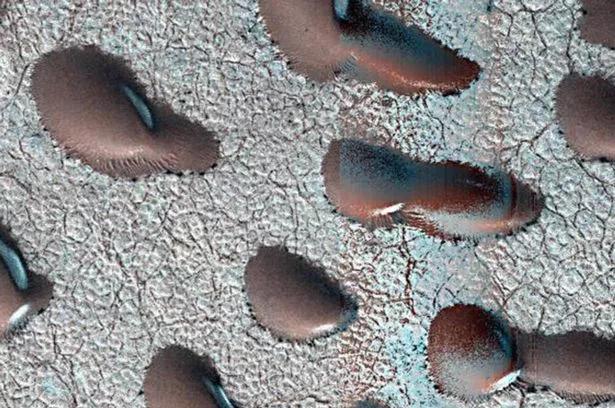Kidney Bean-Shaped Sand Dunes Spotted On Mars Could Hold Clues To Life
News Mania Desk / Piyal Chatterjee / 15th january 2025

NASA’s Mars Reconnaissance Orbiter (MRO) captured a breathtaking image of the Red Planet’s surface featuring frozen sand dunes in the northern hemisphere, shaped like a kidney bean. The image, captured by the High-Resolution Imaging Science Experiment (HiRISE) camera in September 2022 and made public just last month, may assist in determining whether conditions on Mars were capable of supporting life long ago.
In contrast to the ever-moving dunes on Earth, the kidney bean-shaped dunes on Mars seem remarkably still. According to NASA, the dunes shown in the image are blanketed by a layer of carbon dioxide frost in the winter season on Mars. In the winter months, the poles of the planet can see nighttime temperatures drop to -123 degrees Celsius, creating perfect conditions for snowfall and frost development. However, in contrast to Earth’s snow, Mars’ snow exists in two varieties: water ice and frozen carbon dioxide, known as dry ice.
The frost, consisting of water ice and carbon dioxide ice, halts the wind from lifting the sand and keeps the dunes from moving until the thaw of spring arrives. Examining the alterations in carbon dioxide frost under existing conditions might improve our ability to forecast the past climate on Mars.
Researchers have been searching for answers regarding the existence of life on Mars for a long time. In October of the previous year, a NASA study indicated that microbes could potentially inhabit the areas beneath the ice-covered water on the surface of the Red Planet. The researchers found that the quantity of sunlight that reaches the water ice might be sufficient for photosynthesis to take place in the shallow meltwater pools located below the ice’s surface.
A month later, a study conducted by researchers at Harvard’s Paleomagnetics Lab indicated that Mars’ magnetic field, potentially capable of supporting life, might have endured significantly longer than earlier assumptions. Although Mars is currently frigid, desolate, and rocky, findings indicate that its magnetic field might have persisted until 3.9 billion years ago, in contrast to earlier estimates of 4.1 billion years — positioning the Red Planet as a leading contender for a supportive habitat for life. The additional 200 million years coincide with the period when water began to cover the Martian surface, as shown by data collected from multiple rovers dispatched by NASA.






